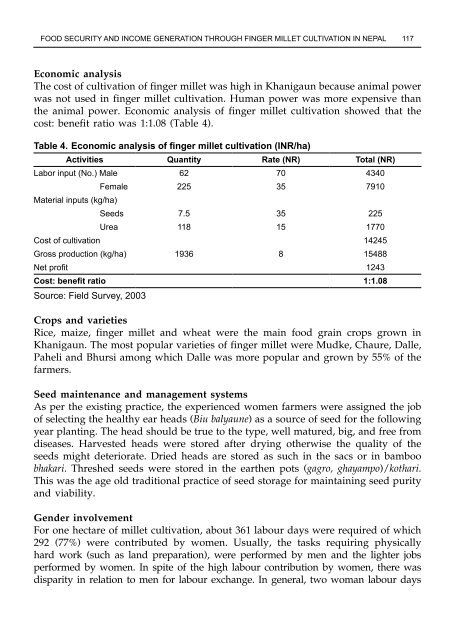Minor millets in South Asia: learnings from IFAD-NUS project in India ...
Minor millets in South Asia: learnings from IFAD-NUS project in India ...
Minor millets in South Asia: learnings from IFAD-NUS project in India ...
You also want an ePaper? Increase the reach of your titles
YUMPU automatically turns print PDFs into web optimized ePapers that Google loves.
Food seCuritY and <strong>in</strong>Come generation through F<strong>in</strong>ger millet CultiVation <strong>in</strong> nepal 117<br />
Economic analysis<br />
The cost of cultivation of f<strong>in</strong>ger millet was high <strong>in</strong> Khanigaun because animal power<br />
was not used <strong>in</strong> f<strong>in</strong>ger millet cultivation. Human power was more expensive than<br />
the animal power. Economic analysis of f<strong>in</strong>ger millet cultivation showed that the<br />
cost: benefit ratio was 1:1.08 (Table 4).<br />
Table 4. Economic analysis of f<strong>in</strong>ger millet cultivation (INR/ha)<br />
Activities Quantity Rate (NR) Total (NR)<br />
labor <strong>in</strong>put (no.) male 62 70 4340<br />
material <strong>in</strong>puts (kg/ha)<br />
Female 225 35 7910<br />
seeds 7.5 35 225<br />
urea 118 15 1770<br />
Cost of cultivation 14245<br />
gross production (kg/ha) 1936 8 15488<br />
Net profit 1243<br />
Cost: benefit ratio 1:1.08<br />
source: Field survey, 2003<br />
Crops and varieties<br />
Rice, maize, f<strong>in</strong>ger millet and wheat were the ma<strong>in</strong> food gra<strong>in</strong> crops grown <strong>in</strong><br />
Khanigaun. The most popular varieties of f<strong>in</strong>ger millet were Mudke, Chaure, Dalle,<br />
Paheli and Bhursi among which Dalle was more popular and grown by 55% of the<br />
farmers.<br />
Seed ma<strong>in</strong>tenance and management systems<br />
As per the exist<strong>in</strong>g practice, the experienced women farmers were assigned the job<br />
of select<strong>in</strong>g the healthy ear heads (Biu balyaune) as a source of seed for the follow<strong>in</strong>g<br />
year plant<strong>in</strong>g. The head should be true to the type, well matured, big, and free <strong>from</strong><br />
diseases. Harvested heads were stored after dry<strong>in</strong>g otherwise the quality of the<br />
seeds might deteriorate. Dried heads are stored as such <strong>in</strong> the sacs or <strong>in</strong> bamboo<br />
bhakari. Threshed seeds were stored <strong>in</strong> the earthen pots (gagro, ghayampo)/kothari.<br />
This was the age old traditional practice of seed storage for ma<strong>in</strong>ta<strong>in</strong><strong>in</strong>g seed purity<br />
and viability.<br />
Gender <strong>in</strong>volvement<br />
For one hectare of millet cultivation, about 361 labour days were required of which<br />
292 (77%) were contributed by women. Usually, the tasks requir<strong>in</strong>g physically<br />
hard work (such as land preparation), were performed by men and the lighter jobs<br />
performed by women. In spite of the high labour contribution by women, there was<br />
disparity <strong>in</strong> relation to men for labour exchange. In general, two woman labour days

















